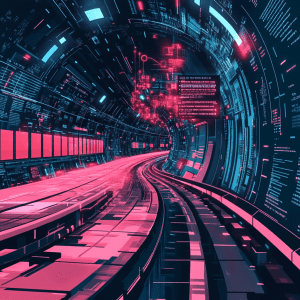The Evolution and Impact of AI in Cybersecurity
 The digital age’s relentless pace has brought about a silent revolution: the merger of Artificial Intelligence (AI) with cybersecurity. As these two domains intertwine, a new frontier emerges, replete with opportunities and challenges. This article delves into the transformative role AI plays in cybersecurity, shedding light on its myriad applications, the challenges it brings, and the future it promises.
The digital age’s relentless pace has brought about a silent revolution: the merger of Artificial Intelligence (AI) with cybersecurity. As these two domains intertwine, a new frontier emerges, replete with opportunities and challenges. This article delves into the transformative role AI plays in cybersecurity, shedding light on its myriad applications, the challenges it brings, and the future it promises.
(Check Out My Book: Hacked: A Select Cinematic History of Cybersecurity)
Understanding AI in Cybersecurity
Artificial Intelligence’s incursion into cybersecurity heralds an era where algorithms determine security strategies. Gone are the days when cybersecurity was purely about human intuition; today, machines predict, analyze, and sometimes even prevent threats with astonishing accuracy.
(Visit Jason's Amazon Authors Page)
Moreover, AI’s prowess lies in its ability to process voluminous data at breakneck speed. In a world where data breaches are often catastrophic, AI stands as a beacon, detecting vulnerabilities and anomalies faster than any human ever could. Traditional threat detection methods, often tedious and time-consuming, now face obsolescence as AI offers real-time data analysis.
Yet, this merger isn’t about replacing human skills. Instead, AI augments our abilities, allowing cybersecurity professionals to focus on more complex tasks. By swiftly handling routine analyses, AI allows us to tackle nuanced challenges, making the combination of man and machine a formidable defense force.
Recommendation: Cybersecurity professionals should invest time in understanding AI’s fundamentals, ensuring they can leverage its capabilities while maintaining vital human oversight.
AI’s Formidable Role in Threat and Fraud Detection
The scope of AI’s impact on cybersecurity is expansive, but its role in threat detection stands out. No longer reliant on manual processes, companies can now trust AI to identify malicious patterns, saving both time and resources.
The finance sector serves as a testament to AI’s capabilities in fraud detection. Banks and financial institutions now utilize AI to scrutinize transaction patterns, mitigating the risk of massive financial losses. By identifying inconsistencies and potential threats, AI plays a crucial role in ensuring financial security.
However, AI’s real beauty lies in its adaptability. As cyber threats evolve, AI algorithms can be trained to recognize new patterns, ensuring organizations remain one step ahead of potential attackers.
Recommendation: Companies, especially those in data-sensitive sectors like finance, should integrate AI-driven threat and fraud detection tools, ensuring they’re equipped for the ever-evolving threat landscape.
Privacy, Machine Learning, and the Changing Landscape
Despite its merits, the amalgamation of AI with cybersecurity isn’t devoid of challenges. AI’s insatiable appetite for data, vital for its efficiency, raises pressing privacy concerns. While it serves as a guardian against threats, ensuring it doesn’t overstep into the realm of intrusion is paramount.
Enter Machine Learning (ML) – AI’s sophisticated subset. ML’s iterative learning ensures that with every encountered threat, the system becomes smarter. However, as it delves deeper into data for learning, striking a balance between enhanced security and privacy preservation becomes vital.
Moreover, when breaches occur, AI provides invaluable insights to incident response teams. By dissecting data, it paves the way for faster resolutions, minimizing potential damages. Yet, as systems grow more autonomous, the question of ethical boundaries looms large.
Recommendation: Organizations should create clear guidelines on data access for AI and ML tools, ensuring privacy remains uncompromised while maximizing security benefits.
Gazing into the Future: What Lies Ahead
Predictive analytics, collaboration, ethics— the future of AI in cybersecurity promises a paradigm shift. Imagine a world where security systems don’t just react but anticipate threats. With AI’s predictive capabilities, this is no longer the stuff of science fiction but an emerging reality.
In the not-so-distant future, AI systems might collaborate across organizations. This shared intelligence, a collective defense mechanism, could be the key to thwarting sophisticated cyber adversaries. Yet, as systems grow smarter, ensuring they remain within ethical confines is crucial.
Continual adaptation will be the hallmark of future AI-driven security. As threats morph, so will AI defenses, ensuring that organizations are always prepared for what lies ahead.
Recommendation: Cybersecurity professionals should remain abreast of advancements in AI, ensuring they are prepared for the future challenges and opportunities it presents.
Conclusion:
As AI continues its march into the realms of cybersecurity, it ushers in a new era of possibilities and challenges. By understanding its profound implications and preparing for its inevitable evolution, we not only secure our present but also pave the way for a safer, more secure digital future.
